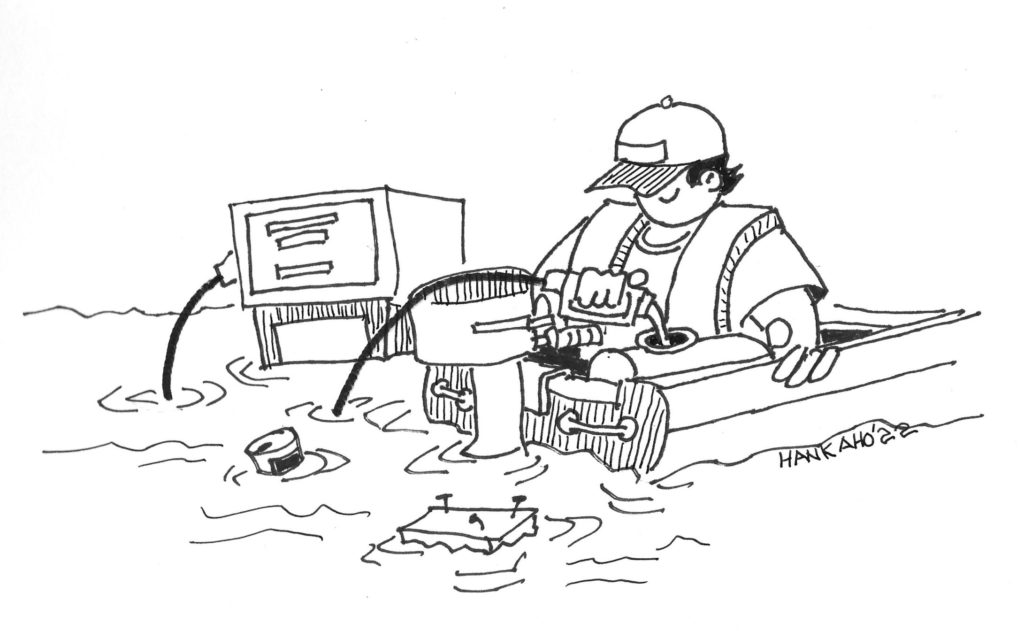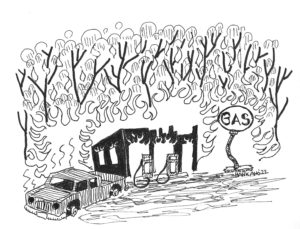Dealing with Climate Change and Natural Disasters

A Message From Mark Barolo
Acting Director, U.S. EPA’s Office of Underground Storage Tanks
The effects of climate change are a concern for the underground storage tanks (UST) community — specifically related to increased risks of flooding, drought, and wildfire. The Met Office annual global temperature forecast predicts that 2022 will rank as one of the world’s hottest years on record, with a temperature forecast of between 0.97°C and 1.21°C above the average for the pre-industrial period (1850-1900). Hotter temperatures associated with climate change can affect the frequency and duration of precipitation events, potentially impacting the frequency of floods. Modeling indicates that we can expect continued and more significant changes to precipitation patterns and snowmelt changes, an increased risk of dry soils, and more frequent and severe wildfires. While all of that might be valid, is it really a concern for our underground storage tank inventory?
Yes! The UST universe is already susceptible to growing climate risks, particularly from heavy precipitation, droughts, and wildfires, as we have seen over the last several years. Further, the impacts of climate change complicate how we plan for and execute cleanups of fuel releases. Both prevention and cleanup actions require adapting to the risks of climate change, something every industry must face. EPA is working on a variety of efforts to help understand and prepare for these climate-related changes in our industry.
We have seen how hurricanes, bringing high winds and storm surge from the impact of very strong but fast-moving storms, can be punishing for UST locations. But even slower-moving storms, like Hurricane Florence, can bring devastating flooding from continued heavy rainfall. Flooding effects on UST systems from either type of storm can include buoyancy, erosion and scour, product displacement, and electrical system damage.
Climate change can also worsen corrosion challenges, which are already a risk for nearly all UST systems. The 1988 federal UST regulation required corrosion protection for any components in contact with the ground, but sometimes components in sumps or inside of tanks are still affected even when other parts of the system are protected. These corrosion risks in UST systems may be accelerated by warmer temperatures, and by increased exposure to brackish or salt water. The latter occurs through intrusion of saltier water into inland water tables in coastal areas, as seas rise and freshwater recharge rates change, and by more frequent water exposures either through storms or tidal flooding.
According to data posted by the National Interagency Fire Center, for each of the years 2015, 2017, and 2020, over 10 million acres of land burned in the United States. In addition to the tragic loss of lives, homes, and communities, these fires contribute significantly to air pollution, adding fine particulates, carbon monoxide, nitrogen dioxide, formaldehyde, and acetaldehyde to the environment. Already in 2022, almost 6 million acres have been claimed by wildfire.
Most people are familiar with footage of smoke and burned areas but may be less aware of the impact these fires can have on gas stations or other UST systems. Fires can burn an UST facility, causing damage to equipment that might not be readily observed. Ensuring USTs are operated and in compliance with regulations helps all of America adapt to climate change in a very important manner: being prepared for emergencies that can be more damaging or happen more frequently in a warming world. Responsibly adapting to climate risks includes regularly updating evacuation planning to ensure the public can evacuate danger zones in time and ensuring first responders can reach response areas to fight fires or rescue residents trapped in floods. Gas stations en route to impact areas are critical to ensure both evacuees and responders have access to gas, food, and emergency supplies they need, where and when they need it.
UST programs need to work together to understand and adapt to the risks posed by climate change on the frequency and severity of natural disasters, particularly in terms of flooding and wildfire. What actions is the Office of Underground Storage Tanks (OUST) taking?
Guidances
We in OUST work to ensure that the tanks community has access to useful information to prepare for and then recover from natural disasters impacting the tanks inventory. OUST has prepared two such guides to date with tremendous support from our state, tribal, and industry partners.
The Underground Storage Tank Flood Guide. The flood guide provides simple guidelines and useful information for regulators, owners, and operators in the event of a threatened or actual flood. It details important actions to take after the disaster strikes and provides information on financial assistance. It consolidates information from various federal, state, nongovernmental, and UST industry resources. UST and AST checklists are provided to help owners and operators prepare for, prevent, or lessen the catastrophic effects and environmental harm that could occur as a result of flooded storage tank systems, as well as help them return their systems to service as soon as possible.
The Wildfire Guide: Preparation And Recovery For Underground And Aboveground Storage Tank Systems. Because many UST facilities also include aboveground storage tank systems, our wildfire guide provides information and resources for both UST systems and ASTs storing oil. Information in the guide can help owners and operators prepare for and respond to the catastrophic effects and environmental harm that may occur as a result of partially or fully burned UST systems or oil ASTs and associated piping and appurtenances. State, local, and tribal UST and oil AST program implementers may also find this guide useful.

Working with EPA’s Office of Research and Development (ORD)
At the end of March 2022 there were 538,704 federally regulated petroleum USTs in the United States. OUST and ORD developed UST Finder, a national geospatial database identifying USTs and their proximities to populations and drinking water sources. UST Finder provides the attributes and locations of active and closed USTs, UST facilities, and UST releases from states as of 2018 to 2020 and from tribal lands and U.S. territories as of 2020 to 2021. UST Finder can identify USTs that are potentially vulnerable to, or have been impacted by, flooding, drought, or wildfires, enabling regulators to focus attention on the risks and response needs for these facilities.
ORD is collaborating with the National Oceanic and Atmospheric Administration (NOAA) to develop a flooding notification system for owners that will be incorporated into UST Finder. Providing a warning system to identify and alert owners and operators of any flooding anticipated within the upcoming ten days will allow them to be more prepared for flood events. Linking UST locations with severe weather warning systems will also improve emergency response capabilities in case an emergency response to an UST release is required.
What is on the Horizon?
On January 27, 2021, President Biden signed Executive Order (EO) 14008: Tackling the Climate Crisis at Home and Abroad. Among other things, this EO directed agencies to develop climate adaptation actions plans. By May 2021, in a policy statement on climate change adaptation, EPA Administrator Regan directed the 2014 EPA Climate Adaptation Implementation plans to be updated. The Office of Land and Emergency Management (OLEM) is currently developing a plan which will build on progress achieved since 2014 and identify priority actions to be accomplished in 2022 and 2023. This plan is scheduled to be made public by the end of September 2022.
In the near term, OUST will redouble our efforts to partner with you to ensure you have access to support documents as well as the technical tools you need to prepare for and recover from natural disasters that impact your facilities. The UST Program has taken on many challenges over the years. It will take all our collective efforts to chart a path forward and adapt to the conditions associated with climate change. I look forward to working with all our partners to continue to prepare our program for the impacts of climate change and to continue protecting human health and the environment.
I invite readers to share their thoughts and ideas with OUST regarding what more we can or should do to prepare for and respond to the risks to the UST inventory associated with climate change. Feel free to share your thoughts with me, barolo.mark@epa.gov, or with Linda Gerber, gerber.linda@epa.gov.

